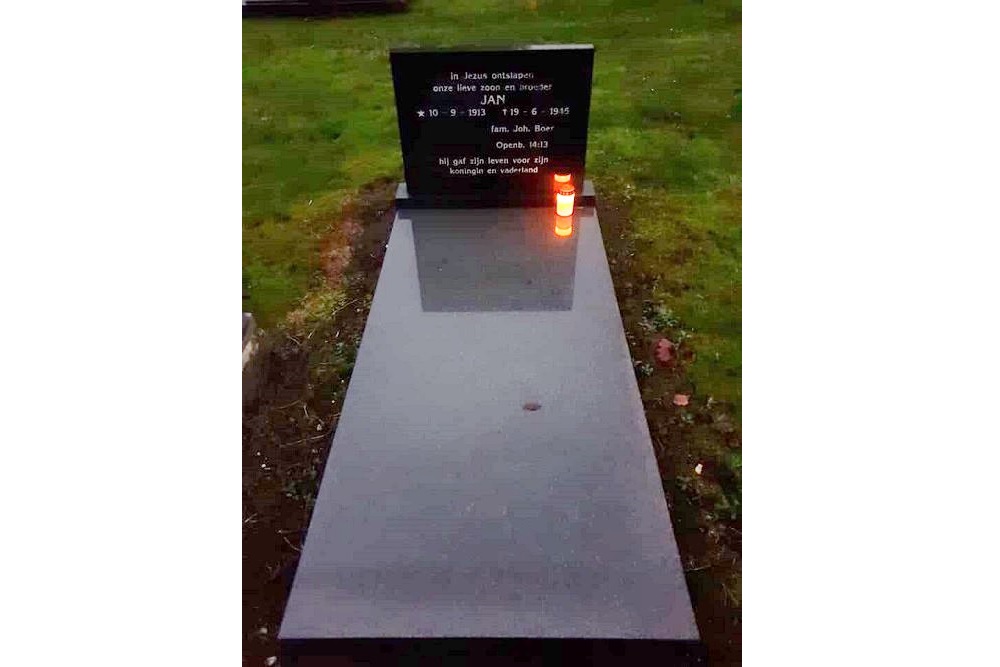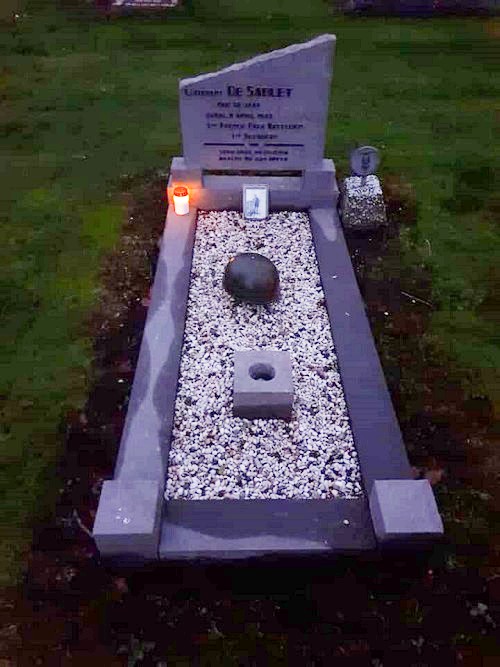War Graves Cemetery Bovensmilde
In Bovensmilde in Drenthe on the Witterweg is a cemetery with 2 graves. 1 of a resistance fighter and 1 of a killed SAS French soldier.
Jan Boer
Jan Boer was born on September 10, 1913 in Bovensmilde. His occupation was potato grower. During the war, he joined the Dutch Internal Forces, where he was involved in illegal activities against the German occupier. The Boer family secretly listened to an English channel in the attic. Jan typed these messages on paper and ensured distribution within the municipality of Smilde. The German occupier took strong action against this kind of illegal activity. Due to the indiscretion of a former member of the resistance group against a black trader, a dark time began. The black dealer agreed with the Germans that he would be released if he mentioned the names of resistance members. Jan had smelled danger before and had come to the conclusion that it was no longer safe for him to continue living at home. He therefore went into hiding on a farm in Schoonoord. In 1942, however, Jan is arrested during a raid and ends up in Dachau via Assen and Scheveningen. Jan is used as a forced labourer. The camp is liberated by the Allies at the end of April 1945. The Allies were so shocked by the poor conditions in Dachau that the camp guards were executed on the spot. After 2.5 years of captivity, Jan experienced the liberation greatly weakened. The Allies transport him by plane to the Netherlands. However, his health is so bad that he can no longer tolerate the food that is given to him. He died in Maastricht on 19 June 1945. On June 25, 1945, he was buried at the municipal cemetery in Bovensmilde. Jan Boer's name appears on the honor roll 1940-1945.
Gabriel de Sablet
On the night of April 7-8, 1945, Gabriel de Sablet jumped out of a plane with a parachute to participate in Operation Amherst. Operation Amherst was the Allied code name for an operation intended to prepare for the Canadian attack on the city of Groningen.
Lieutenant de Sablet jumped together with his "stick" (a group of paratroopers from the SAS) with the intention that he would land in the municipality of Norg. Sablet jumped first that night but got entangled in his parachute and landed in a deep peat ditch in the municipality of Smilde. Here he died by drowning. His lifeless body was found the next morning. By order of the German occupiers, his body had to remain there on the shore and was not allowed to be buried. A resistance group did not obey this German order and later secretly buried the body. Fortunately, the rest of Sablet's "stick" landed in the municipality of Norg and made a major contribution to the liberation of the north of our country. In 1951 the Sablet was awarded the bronze cross.
Do you have more information about this location? Inform us!
Source
- Text: Oranje Feest Vereniging Bovensmilde
- Photos: Matthijs ten Napel
Nearby
Museum
- Stoottroepenmuseum - Johan Willem Frisokazerne - Assen
- Camp Westerbork Remembrance Centre - Hooghalen
- Nationaal Gevangenismuseum - Veenhuizen
Point of interest
- Veenhoopsbrug Smilde - Smilde
- The List of Master Braaksma - Assen
- NSB District Office Drenthe - Assen
Monument
- Resistance Memorial Smilde - Smilde
- Memorial Dutch East Indies and Korea - Smilde
- Jewish Memorial Smilde - Smilde
Cemetery
- Dutch War Graves Smilde - Smilde
- French War Graves Smilde - Smilde
- Dutch War Grave De Boskamp Cemetery - Assen
Remembrance Stone
- Stumbling Stone Witterweg 1 - Smilde
- Stumbling Stone Kanaalweg 132 - Smilde
- Stumbling Stone Kanaalweg 126 - Smilde
Fortification
- German Antitank Ditch Assen - Assen
- German Antitank Ditch Assen - Assen
- German Anti-tank Ditch Zuid Hijkingerzand - Hijken






